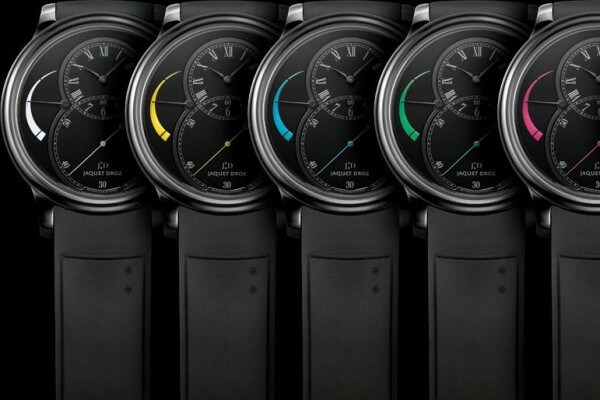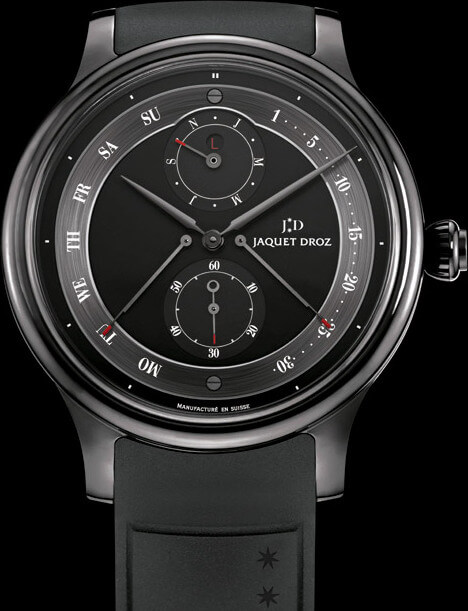Part of the Swatch Group since 2000, Jaquet Droz manufactures contemporary timepieces which are inspired by the art of watchmaking in the eighteenth century, when Pierre Jaquet Droz rose to fame. The brand transposes the aesthetics and artisanal techniques of that era to the twenty-first century, giving rise to models of the utmost purity, almost always with gold cases. Responding to rising demand, Jaquet Droz has nonetheless made use of other materials, beginning with steel. Ceramic, which joined the collections in 2008, has its rightful place at Jaquet Droz, whose specialities include Grand Feu enamel dials. Indeed, ceramic, like enamel, is obtained from a powder which is fired at high temperature. A fortunate coincidence which Jaquet Droz has taken to a degree of exclusivity, worthy of fine watchmaking.
An ultra-refined medium
One of the distinguishing qualities of the ceramic for a Jaquet Droz watch is the exceptional fineness of the zirconium oxide powder from which it is made. Each grain has been reduced to the smallest possible diameter of 0.2 micrometer compared with the usual 0.5 micrometer. Such fineness means more powder is required to manufacture each piece. The additional cost this implies is justified by a hardness of some 1,300 HV on the Vickers scale, porosity of less than 0.1% instead of 0.2%, and greater resilience. More scratch-resistant, this ceramic also has a smoother aspect than ever before – this reduction in imperfections is clearly visible under a loupe – that is fully revealed by the final polishing.
A special mould is produced, at considerable cost, for each ceramic part. Once filled with powder, these moulds are fired in the kiln where, under the effect of intense heat, the powder is fritted, that is it agglomerates, losing much of its volume, and takes on a vitreous sheen. As with enamel, this is a delicate operation because the ceramic could shatter at any point. A Jaquet Droz ceramic case requires three separate moulds: one for the bezel, a second for the middle, and a third for the back. This represents an unprecedented degree of sophistication compared with other ceramic cases, which are made in just one or two parts; others are metal with a ceramic coating. An additional difficulty lies in the delicate curve of the case. These creations by Jaquet Droz mark the advent of cases made entirely from ceramic in fine watchmaking.
These 100% Swiss-Made timepieces draw on the expertise and constant innovation of Comadur, a Swatch Group company. They make exemplary use of a material whose properties – anallergic, athermic and, as previously mentioned, extreme scratch-resistance – are highly coveted in watchmaking. At Jaquet Droz, ceramic is raised to superlative status. It takes on a breathtakingly pure, deep lustre, whether it is white, made from zirconium oxide, or black, made from zirconium oxide with pigments incorporated into the crystal lattice.
A further challenge
This year, Jaquet Droz has pushed back the limits of technology with its Quantième Perpétuel Céramique, the first grande complication – a perpetual calendar – to be housed inside an entirely ceramic case. Adding to the complexity of this piece are the thickness of the case middle – the thicker it is, the more pronounced its curve – and to an even greater extent the incorporation of flat-head correctors into a rounded profile. These are set inside drops, formed in the mass, to ensure a harmonious line. Piercing this hard and equally dense material without chipping it introduces a further risk of causing irreversible damage. The Quantième Perpétuel Céramique has no doubt reached the limits of what it is currently possible to achieve. Produced as a limited edition of 88 in black, it displays central hours and minutes, small seconds at 6 o’clock, date and day by retrograde hands, and month and leap year at 12 o’clock.

Additionally, the Réserve de Marche Céramique, unveiled last year with a blood-red indicator, now lends itself to a rainbow of colours. The power reserve sweeps a curved scale, made brilliant by successive applications of lacquer. Fuchsia, green, blue, yellow and white add Technicolor to dials which are as intensely black as the ceramic cases and rubber straps. A limited edition of 8 pieces in each colour.














